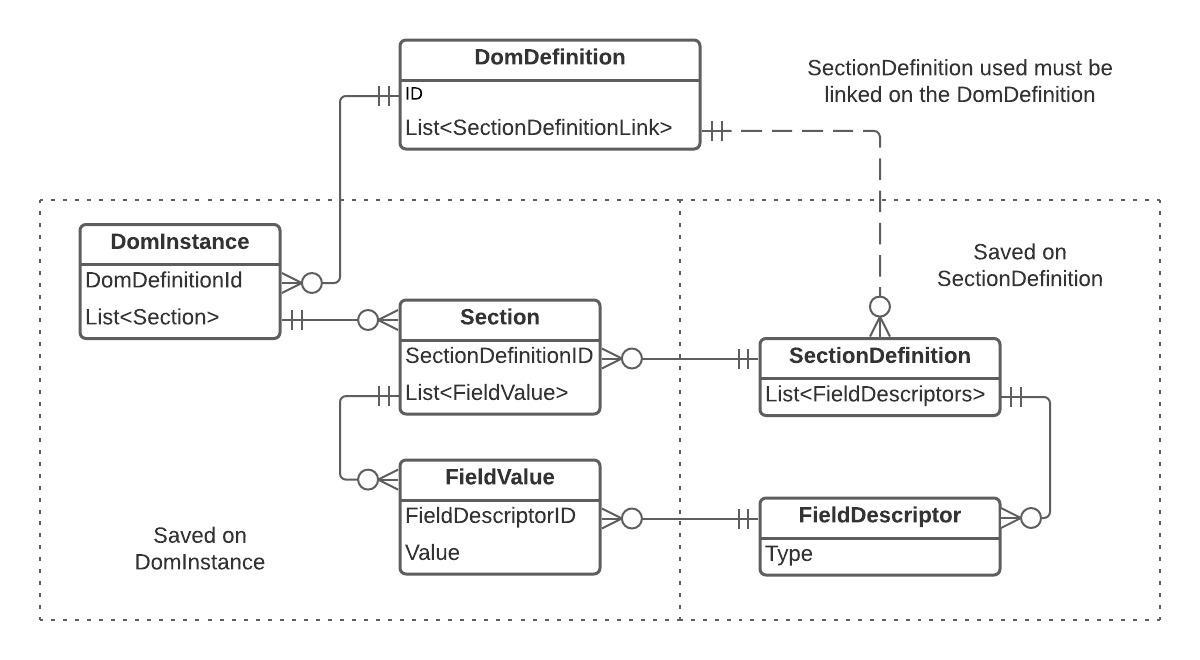DOM objects
The most basic DOM object is the DOM instance (or DomInstance in the code), which contains different values (e.g. names, dates, IDs, etc.). A DOM definition (or DomDefinition) determines which sections are present in DOM instances, by grouping a number of section definitions. Each section definition (or SectionDefinition) defines the data that should be present in a section of a DOM instance (e.g. the type of data and the number of fields).
In addition to this, a DOM template (or DomTemplate) can also be defined, which is a DOM instance object that already has specific values filled in. Finally, a DOM definition can be linked to a DOM behavior definition (or DomBehaviorDefinition), which contains configuration for extra behavior (e.g. different statuses).
In summary:
SectionDefinition: Defines the data that should be present in a section of a DOM instance, using field descriptors.
DomDefinition: Groups DOM instances together and defines which section definitions should be used by the instances.
DomInstance: Contains field values in its different sections, as defined in the section definitions, which in turn are defined by the DOM definition.
DomTemplate: DOM instance with filled-in values that can be used as a template.
DomBehaviorDefinition: Extension of a DOM definition that adds additional behavior configuration.
The following diagram illustrates the relation between these objects:

For example, to create a system that stores time spent working on specific tasks registered by employees, you could create a SectionDefinition with the name "PunchInfoSectionDefinition", consisting of the following field descriptors:
Field descriptor 1: Name = "Task ID" and Type = "GUID"
Field descriptor 2: Name = "Username" and Type = "String"
Field descriptor 3: Name = "Start time" and Type = "DateTime"
Field descriptor 4: Name = "Stop time" and Type = "DateTime"
A DOM definition will then need to be created that contains a link to this section definition, so that employees can then register time by creating a new DOM instance linked to that DOM definition. The DOM instance will have a section linked to the section definition that contains a field value for each of the field descriptors.
ITrackBase Properties
From DataMiner 10.3.2/10.4.0 onwards, all DOM objects (including the ModuleSettings) contain four properties that reflect who has created/updated the object, and at what time.
LastModified: The moment when the object was last modified, in UTC DateTime format.
LastModifiedBy: The full username (string) of the user who last modified the object.
CreatedAt: The moment when the object was created, in UTC DateTime format.
CreatedBy: The full username (string) of the user who created the object.
Since these are seen as metadata, they are not immediately accessible on the objects, but require a cast.
DateTime lastModified = ((ITrackBase) domInstance).LastModified;
string lastModifiedBy = ((ITrackBase) domTemplate).LastModifiedBy;
DateTime createdAt = ((ITrackBase) moduleSettings).CreatedAt;
string createdBy = ((ITrackBase) sectionDefinition).CreatedBy;
It is also possible to use these fields to build filters when reading objects.
var filter = DomInstanceExposers.CreatedBy.Equal("John Doe");
Note
The DOM objects created prior to DataMiner 10.3.2/10.4.0 will not have a value for these fields. However, after an existing object is updated once, the LastModified and LastModifiedBy fields will be filled in.
Soft-deletable objects
From DataMiner 10.3.9/10.4.0 onwards, the following DOM objects can be soft-deleted:
When the fields linked to a soft-deleted FieldDescriptor or part of a soft-deleted SectionDefinitionLink or DomStatusSectionDefinitionLink are marked as IsSoftDeleted, the following applies:
- The fields will not be shown in a UI form.
- The fields are not validated when the
SectionDefinition,DomDefinition, orDomBehaviorDefinitionis updated. - The fields are never required.
- Values are allowed to exist in the fields on a
DomInstancefor a soft-deletedFieldDescriptor,SectionDefinitionLink, orDomStatusSectionDefinitionLink. - Updating a
DomInstancewith new/updated values will be blocked for a field that has a soft-deletedFieldDescriptor, or is part of a soft-deletedSectionDefinitionLinkorDomStatusSectionDefinitionLink(for that status). A ValueForSoftDeletedFieldNotAllowed error will be returned.
From DataMiner 10.3.10/10.4.0 onwards, it is also possible to soft-delete a GenericEnumEntry<T> in a GenericEnum<T> on a GenericEnumFieldDescriptor. When an entry is marked as soft-deleted, it will no longer be shown in UI forms, except for an edit form where the value for the GenericEnum field is the soft-deleted value. It is not possible to create a DomInstance with a soft-deleted entry as value, or to update a DomInstance enum field to a soft-deleted entry; this will return a ValueForSoftDeletedFieldNotAllowed error. A DomInstance that has a soft-deleted entry as value can continue to exist and can still be updated.